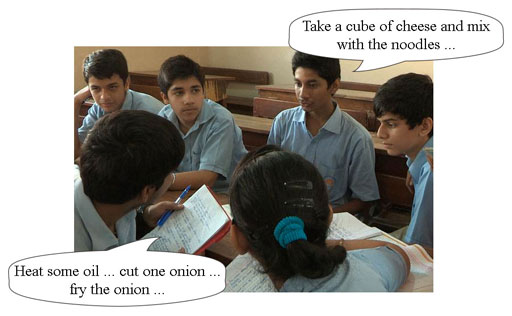3 Using other resources to practise English grammar
You can find examples of grammar structures that students need to learn in English textbooks. You can also find them in texts that you encounter in your daily life, such as newspapers, magazines, advertisements – even wedding invitations. There are many advantages of using real texts to illustrate a grammar point. They:
- help students understand that grammar is more than a set of rules to memorise
- prepare them to use such structures themselves in speech and writing
- encourage them to see grammar and English as being a relevant subject in their lives.
(See the unit Local resources for teaching English for further examples of everyday texts that you could use in your English classes, as well as Resource 4, ‘Using local resources’.)
Case Study 3: Mrs Chakrakodi uses a food wrapper to review the imperative
Mrs Chakrakodi teaches English in a secondary school. Many of her students have problems with grammar structures that she thinks they should know by now. For instance, her students had problems using the imperative in a textbook exercise. She decided to try something which would help them to remember and use it.
I noticed that instant noodle packets carry quick and simple recipes that even teenagers can try at home. I decided to use recipes to teach my students the imperative.
One day I asked my Class IX students to bring empty instant noodle wrappers to the class. Before talking about making noodles, I started a conversation about what they could cook, and whether they knew how to make tea. We had a whole-class discussion and I elicited from them the steps to make tea, which I put on the board. There were sentences like ‘We boil water’, ‘I put in sugar’, ‘I put in milk’, ‘I add one spoon of milk power’, etc.
Amid a lot of laughter, we argued about whether to put sugar in the cup first, or tea leaves in the water itself, and I finally wrote the steps on the board, making a point to use imperative sentences (‘Pour a cup of water in a kettle and boil …’, ‘Add a spoonful of sugar …’). Without my students necessarily realising it, I was reviewing the use of the imperative and its structure. I pointed out that the first word of each sentence was a verb, and that these sentences give instructions.
With the students ready to use the structure, I divided them into groups and asked them to look at the recipes on the instant noodle wrappers that they had brought from home. Their task was to discuss all the recipes, and to make a new and more interesting one using tips from all of them, using the imperative.
As the students worked I walked around the groups, helping where necessary. After fifteen minutes, I started taking feedback. I asked a student from one of the groups to read out their recipe, which I wrote down on the board. We then discussed the recipe together, trying to add or change details where necessary. We also corrected any mistakes with the imperative.
Activity 3: Using other resources to practise English grammar
This is an activity for you to do with your students.
Here are some everyday objects and texts from real life that have English text. Consider how you could use them to teach grammar:
- An empty food wrapper (Figure 2).
 Figure 2 An instant noodle wrapper.
Figure 2 An instant noodle wrapper. - Newspaper headlines:
- ‘World Cup: defending champions Spain defeated 5–0 by the Netherlands’
- ‘Man caught with 6 gold bars in Goa airport
- Wedding invitations (Figure 3).
There are many ways that you could use these objects to teach grammar. Here are some suggestions, although you may have more ideas that you could share with your colleagues:
- Food packets sometimes have recipes on them. You could use these recipes to teach or review the language of instructions, for example the imperative (‘Heat some oil…’). Students could write recipes using the imperative. The packets could lead to a discussion of how instant noodles are made, or about students' opinions on the best way to cook instant noodles (with cheese, egg, tuna, etc.…)
- The headlines use the passive voice. The full sentences would be ‘The defending champions Spain were defeated 5–0 by the Netherlands’ and ‘A man has been/was caught with six gold bars in Goa airport’. Students could write headlines about local events using the passive voice, or transfer them into the active voice.
- The invitations in Figure 3 highlight the passive and active voice. You could also use them to review adverbs (‘cordially’) or prepositions (‘on Sunday’; ‘at Hotel Park Continental’).
What objects can you collect to teach and review English grammar to your classes? You could even take photos of any examples of English that you see used around you. See Resource 5, ‘Planning lessons’, for more on this.
Plan a lesson to teach and review a grammar point using one of these ideas and resources from food packets, adverts, newspapers or magazines.
Pause for thought Here are some questions for you to think about after trying this activity. If possible, discuss these questions with a colleague.
|
Using resources besides the textbook can make a change for students. Using resources like instant noodle packages can help students notice how English is used around them and how they might use the language for their own purposes.
2 Using the textbook to practise English grammar


